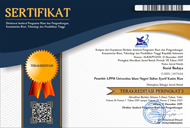The Representation of the Traditional Residential in Jambi Malay Islamic Culture
Abstract
This study examines the relationship between architecture, conservation and tourism in representing a cultural character. This study specifically assesses building regulations which are the product of the Government's collaborative strategy between tourism planning and cultural conservation. The study of research directives focuses on approaches to tourism planning and regulation in maintaining cultural representation. The study uses the Jambi case study, evaluates legally binding guidelines in maintaining traditional architecture and investigates how local values are resistant to vernacular identities. This study shows that in Jambi there is a transformation towards the commercialization of local cultural products as a potential tourist attraction and the effect of modernity.
Keywords
Full Text:
PDFReferences
Bloom, J. (1989). Islamic Tower Symbol. Oxford: University Press.
Bonta, JP. (2018). Architecture and Its Interpretation. New York: Rizzoli.
Dale, PN. (1990). The Myth of Japanese Uniqueness. London: Routledge.
Eitel, EJ. (1984). Fengshui, The Science of Sacred Landscape in Old China. London: Synergetic Press.
Humphrey, C. & Vitebsky, P. (1997). Sacred Architecture. London: Duncan Baird Pub.
Johnson, M. (2016). Housing Culture, Traditional Architecture in an English Landscape. London: UCL Press.
Lynch, K. (1960). The Image of City. Cambridge: MIT Press.
Mann, AT. (1993). Sacred Architecture, Element, Shaftesbury. Dorset.
Mitchell, G. (1978). The Architecture of the Islamic World-History and Its Social Meaning. London: Thame and Hudson Ltd.
Nasir, S.H. (1987). Islamic Art and Spirituality. New York: New York University Press.
Nawawi, N.M. (2000). History of Islamic Architecture. Kuala Lumpur: IIUM.
Norberg-Schulz, C. (1986). Architecture: Meaning and Place. Newyork: Rizzoli International Pub.
Oliver, P. (1987). Dwellings: the House Across the World Phaidon: Oxford.
Petersen, A. (1996). Dictionary of Islamic architecture. London: Psychology Press.
Philip K. H. (1974). History of the Arabs, The MacMillan Press.
Putra, B. A. (2006). Pola Permukiman Melayu Jambi (Studi Kasus Kawasan Tanjung Pasir Sekoja) (Doctoral dissertation, program Pascasarjana Universitas Diponegoro).
Rapoport, A. (1969). House Form and Culture. London: Prentice Hall.
Rapoport, A. (2010). The Mutual Interaction of People and Their Built Environment, A Cross-cultural Perspective. Paris: Mouton Publishers.
Shade, L. R. (2002). The Disneyfication of the World?: Culture and Communication, Department of Communication. University of Ottawa.
Sinaga, A. I. (2016). Islamic culture and culture of islam (as a reflection in rediscovering of standard absorption of culture in islamic teaching). IOSR Journal of Humanities And Social Science (IOSR-JHSS), 21, 90-95.
Stea, D., and Turan, M. (1990). A Statement on Placemaking in Vernacular Architecture. Paradigms of Environment Response, Australia. Ethnoscape Journal, 4, Avebury.
Susan L, D. (1994). Strategies and Structures for Presenting World History with Islam and Muslims. Oxford University Press.
Syed Iskandar, A. (2001). Order in traditional Malay house form. School of Architecture Oxford. Oxford Brookes University.
Thalib, B. R., & Sulieman, M. Z. (2011). Mosques Without Domes: Preserving Traditional Design Mosques in Melaka. Malaysia, The Journal of Islamic Architecture 1.
Tuan, Y. (1990). Topophilia: A Study of Environmental Perception, Attitudes and Values. New York: Columbia University Press.
Tyler, D., Robertson, M., & Guerrier, Y. (1998), Managing Tourism in Cities, Policy, Process and Practice, John Willey & Sons, Chichester.
Vale, L. J. (1992). Architecture, Power and National Identity. New Heaven: Yale University Press.
Wahid, A. (2009). Ilusi Negara Islam: Ekpansi Gerakan Islam Transnasional di Indonesia (1st ed.). Jakarta: LibForAll Foundation.
Waterson, R. (1991). The Living House: An Anthropology of Architecture in SouthEast Asia. Singapore: Oxford University Press.
Waterson, R. (2016). Vernacular architecture in the 21st Century: The Fragile Power of Heritage. Jakarta: 16-17 February.
DOI: http://dx.doi.org/10.24014/sb.v20i1.22862
Refbacks
- There are currently no refbacks.
Published by:
Center for Research and Community Development
Universitas Islam Negeri Sultan Syarif Kasim Riau
Jl. H. R. Soebrantas KM 15,5 ,Tuah Madani, Tampan,
Pekanbaru, Riau 28293
Indexed By:


.jpg)



